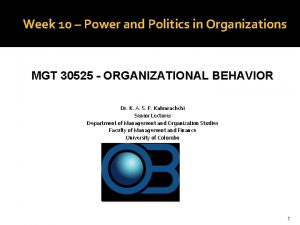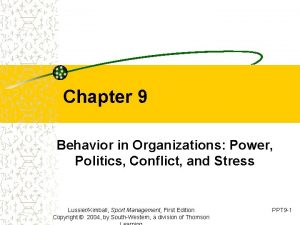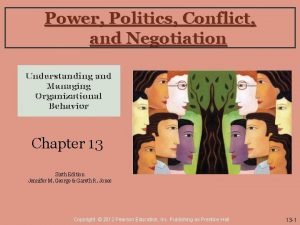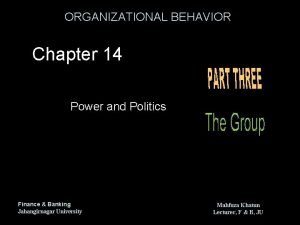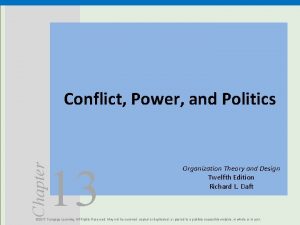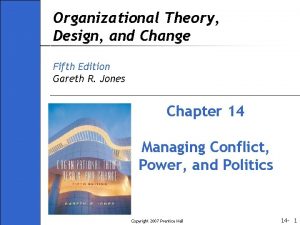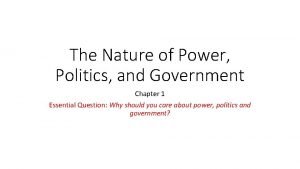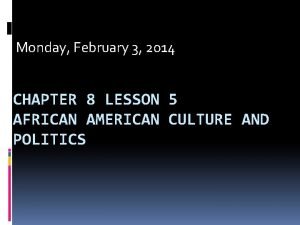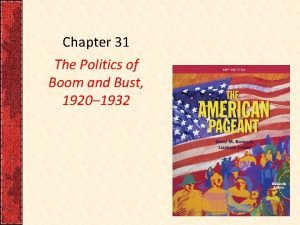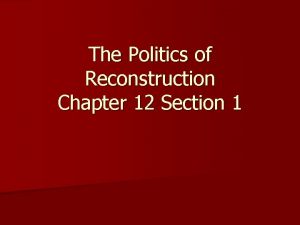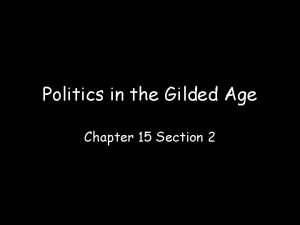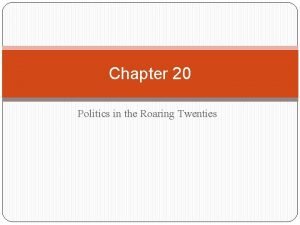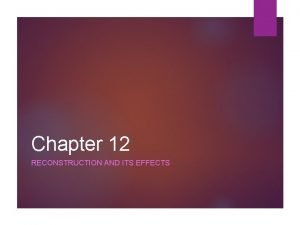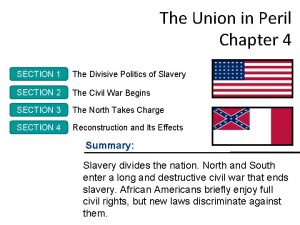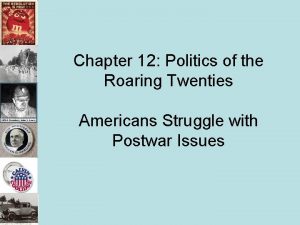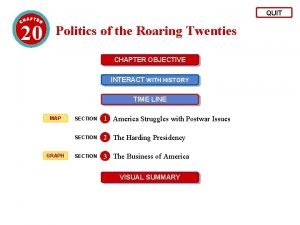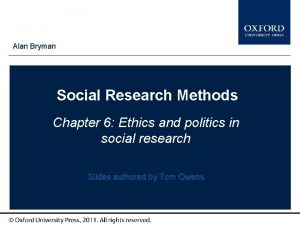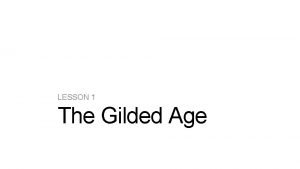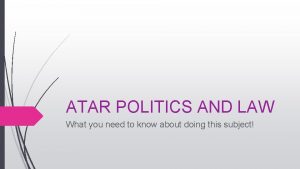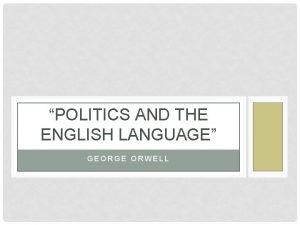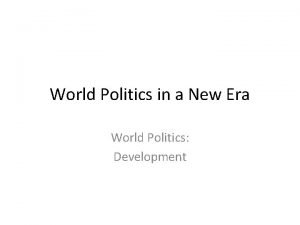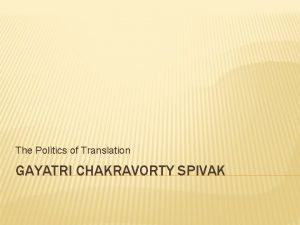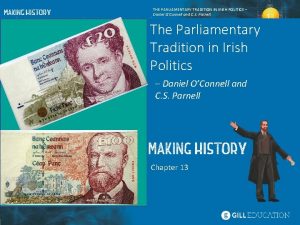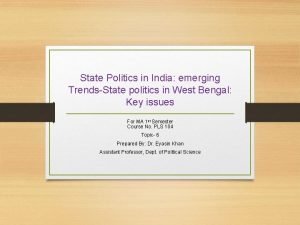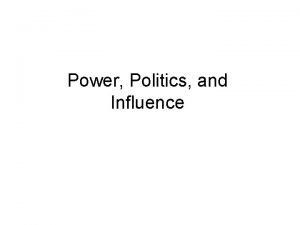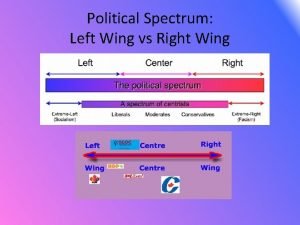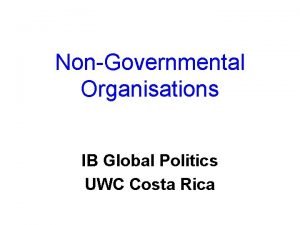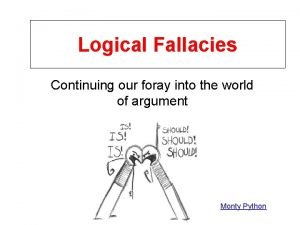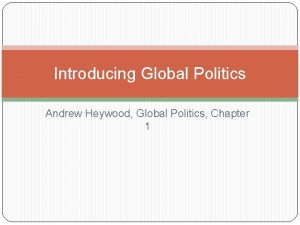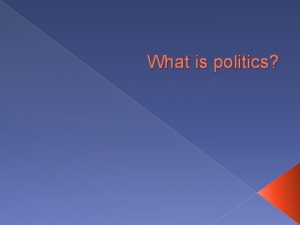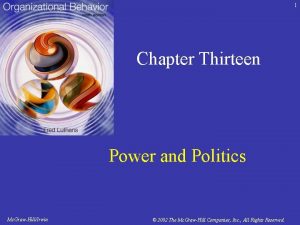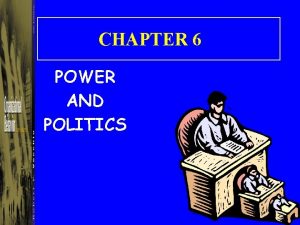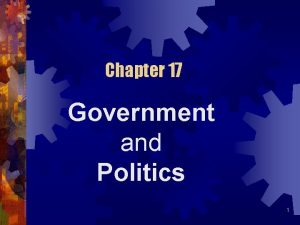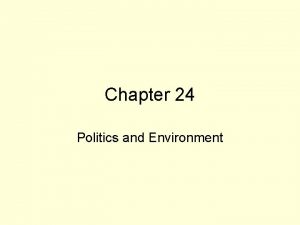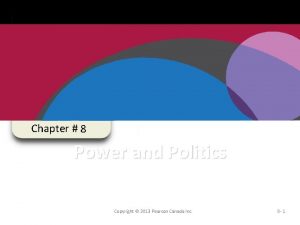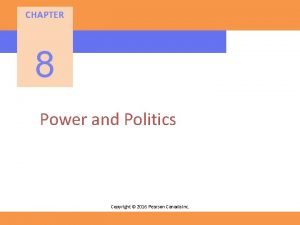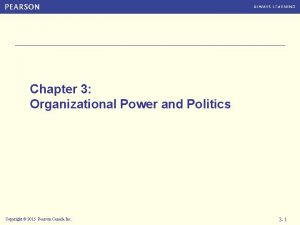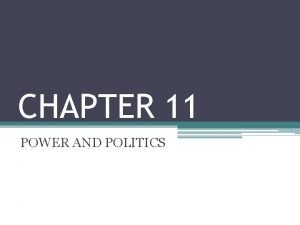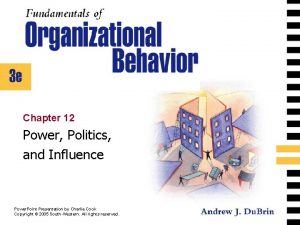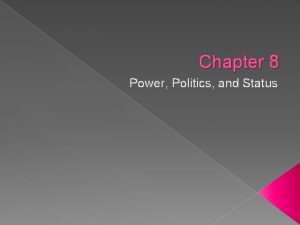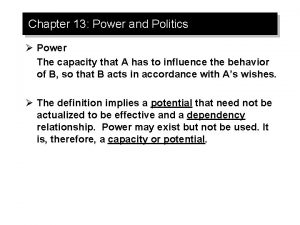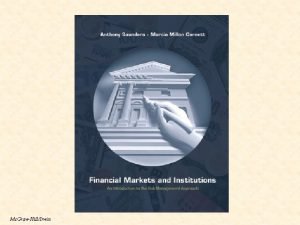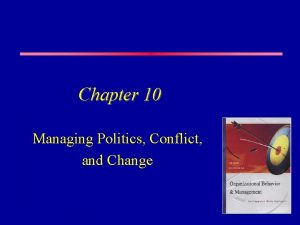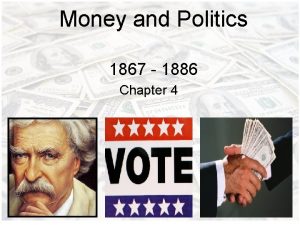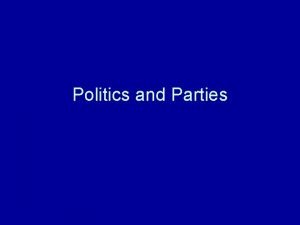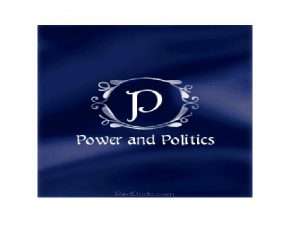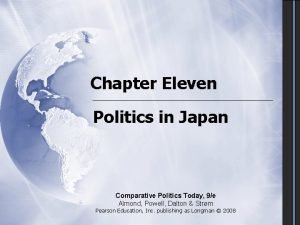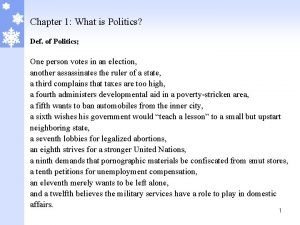Chapter 12 Power and Politics Mc GrawHillIrwin Copyright











































- Slides: 43

Chapter 12 Power and Politics Mc. Graw-Hill/Irwin Copyright © 2014 by The Mc. Graw-Hill Companies, Inc. All rights reserved.

Learning Objectives ■ Distinguish between influence and power Give examples of interpersonal and structural power bases Discuss why some managers resist empowering employees Identify the contingencies that influence subunit or interdepartmental power Explain what is meant by illusion of power ■ Describe several frequently used influence tactics ■ Summarize the criteria for determining ethical behavior ■ Identify the considerations involved in using power to manage effectively ■ ■ 12 -2

Introduction n Power is a pervasive part of organizations ■ n Both managers and non-managers use it A person’s success or failure in using or reacting to power is determined by… ■ ■ ■ Understanding power Knowing how and when to use it Being able to anticipate its probable effects 12 -3

The Concept of Power Influence The capability to get someone to do something (the potential to influence) The exercise of that capability (power in action) 12 -4

The Concept of Power n Power is not a personal attribute ■ ■ It’s an aspect of the relationship that exists between two or more people No individual or group has power in isolation 12 -5

The Concept of Power Obtaining, maintaining, and using power are essential to influencing behavior in organization al settings Symmetrical relationships Both parties have the same amount of power Asymmetrical relationships One person has more power than the other 12 -6

Where Does Power Come From? Legitimate Organizational Power Reward Coercive Interpersonal Power Personal Power Expert Referent Resources Structural Power Decision-making power Information power 12 -7

Empowerment n Defined by Conger and Kanungo as… ■ “Enhancing feelings of self-efficacy among organizational members by identifying and then removing conditions that foster powerlessness” ■ Removal of these conditions may be by formal organizational practices or informal techniques 12 -8

Empowerment is not universally embraced • Managers fear loss of power, control, authority • Employees can’t make responsible decisions • Empowering employees was tried and it failed • Sharing proprietary information means leaking ideas, plans, and knowledge to competitors 12 -9

Empowering Others Increase empowerment effectiveness Delegate authority Be a partner Be supportive Share information Provide training opportunities Provide constructive performance feedback 12 -10

Political Strategies and Tactics Behavior that is outside the legitimate, recognized power system Behavior that benefits an individual or subunit, often at the expense of the organization Behavior that is intentional and designed to acquire and maintain power Political behavior can displace formal power Political behavior can mean 12 -11

EXHIBIT 12. 4 Personal Characteristics of Effective Organizational Politicians 12 -12

Playing Politics n Politics is a fact of organizational life ■ It exists in every organization 12 -13

Reasons Games are Played Resist authority (insurgency) Counter resistance to authority (counter-insurgency) Build power bases (sponsorship, coalition building) Defeat rivals (line versus staff) Bring about organizational change (whistle blowing) 12 -14

Political Influence Tactics Consultation Ingratiating tactics Legitimating Rational persuasion Coalition tactics Personal appeals Inspirational appeals Pressure tactics Exchange tactics 12 -15

EXHIBIT 12. 5 Frequency of Outcomes for the Use of Political Influence Tactics 12 -16

Impression Management n The actions individuals take to control the impressions that others form of them ■ n Impression management is universal Many impression-management tactics are designed to emphasize the positive ■ Creating blatantly false impressions can damage your credibility and reputation 12 -17

Impression Management Actions individuals take to control the impressions that others form of them Self. Promotion Communicating your accomplishments in order to appear able and competent Intimidation Using threats and harassment to appear powerful 12 -18

Self-Handicapping Any action taken in advance of an outcome that is designed to provide either an excuse for failure or a credit for success 12 -19

Ethics, Power, and Politics n Ethical dilemmas exist where power and politics are used to accomplish goals n Examples of unethical behavior ■ ■ Bribing government officials Lying to employees and customers Polluting the environment A general “ends justify the means” mentality 12 -20

Guidelines for Evaluating the Ethics of a Decision 1. 2. 3. Universalism versus Relativism ■ there is a universal ethic which applies to all people, regardless of culture, race, sex, religion, nationality, sexuality or other distinguishing feature, and all the time. ■ Many religions, including Christianity and Islam, have morally universalist positions, and regard their system of morality as having been set by a deity, and therefore absolute, universal, perfect and unchangeable. Justice Approach (Fairness) ■ Distributive justice refers to the equitable allocation of assets in society. ■ Procedural justice refers to implementing legal decisions in accordance with fair and unbiased processes. Utilitarianism ■ 4. The action is right if it promotes happiness for the greatest number of people Universalizability ■ 5. (Distributive, Procedural) Situational – any moral judgment must be equally applicable to every relevantly identical situation Situational – Reasonable Person, Intuition ■ Requires one to act with the same degree of care, knowledge, experience, fair-mindedness, and awareness of the law that the community would expect of a hypothetical reasonable person. 12 -21

Using Power to Manage Effectively n Nothing gets done in any organization until someone makes it happen ■ A manager’s job is making the right things happen 12 -22

Important Power Considerations ■ There are multiple interests in every organization ■ Know what position individuals and groups hold with respect to issues important to you ■ To get things done you must have power ■ In the case of those who oppose you, you must have more power than they do Recognize the strategies/tactics through which organizational power is developed and used ■ 12 -23

Chapter 13 Communication Mc. Graw-Hill/Irwin Copyright © 2014 by The Mc. Graw-Hill Companies, Inc. All rights reserved.

Communication helps organizations The Importance of Communication Accomplish individual and organizational goals Implement and respond to organizational change Coordinate activities Engage in virtually all organizational relevant behaviors 12 -25

The Importance of Communication n Communication itself is unavoidable in a functioning organization ■ n Only effective communication is avoidable Everything one does communicates something, in some way, to somebody ■ The only question is, “With what effect? ” 12 -26

Communication Channels Formula for calculating the number of communication channels: C = N (N-1) 2 Optimal team size: 5 to 10 people 2 people = 1 channel 7 people = 21 channels 4 people = 6 channels 3/4/2021 Project Management Professional Series: 27 12 -27

How Communication Works n Effective communication ■ ■ n Common understanding between a communicator and a receiver Verbal or nonverbal common symbols are used to convey information In an organizational, information flows ■ ■ ■ Vertically Horizontally Diagonally 12 -28

EXHIBIT 13. 1 A General Model of Communication 12 -29

The Elements of Communication Communicator: a person with ideas, intentions, information, and a purpose for communicating Message: an idea or experience that a sender wants to communicate Encoding: converting a message into groups of symbols that represent ideas or concepts Medium of transmission: the carrier of the message Decoding-Receiver: technical term for the receiver’s thought processes Feedback: the receiver’s response to the sender’s message Noise: factors that distort the intended message 12 -30

Information Richness n The amount of information that can be transmitted or communicated effectively ■ ■ n Face-to-face interactions are high in richness A general email to employees is low in richness A medium with high richness ■ ■ Likely to result in common understanding “Real time” communication permits instant feedback 12 -31

EXHIBIT 13. 2 Common Communication Media in 21 st Century Organizations 12 -32

Technology and Communication Internet/Intranet/ Extranet Email, Messaging Social Networks Smart Phones Voice Mail Videoconference Teleconference e. Meeting/ Collaboration 12 -33

Social Networking Sites n Facebook, Twitter, Linked. In ■ Rapidly becoming part of communication fabric ■ Used for a variety of purposes Not exclusive to the young Increasingly monitored by businesses Powerful communication tool that can reach around the world in seconds ■ ■ ■ 12 -34

Voice Mail n Recorded messages account for 90% of telephone communication in organizations ■ n Voice mail is more popular than email Messages are delivered without interruption ■ ■ Communicators can focus on the reason for the call Voice mail minimizes inaccurate messagetaking and time zone barriers 12 -35

Videoconferencing and Teleconferencing n Videoconferencing ■ n Teleconferencing ■ n Refers to technologies associated with viewing Refers to technologies associated with speaking Both allow meetings without getting together face-to-face ■ Increases productivity and reduces travel costs 12 -36

Electronic Meetings n Using software and networked computers to automate meetings ■ Facilitators can poll meeting participants, analyze voting results, create detailed reports 12 -37

Electronic Meetings n Overloading employees with new “toys, ” additional information, and technologies ■ ■ Can reduce efficiency Social interaction is lost Most verbal and nonverbal cues are omitted Anonymity and de-personalization are concerns 12 -38

Interpersonal Communication n Communication flows from person to person in face-to-face and group meetings ■ ■ ■ n Includes instant messaging, video-conferencing Varies from direct orders to casual expressions Includes both verbal and nonverbal forms of communication Communication problems are tied to ■ ■ Perceptual differences Interpersonal style differences 12 -39

Barriers to Effective Communication Frame of Reference Selective Listening Value Judgments Source Credibility Filtering In-Group Language Time Pressures Communication Overload Status Differences 12 -40

Improving Communication in Organizations n To become a better communicator ■ Strive to be understood ■ Strive to understand 12 -41

Techniques to Improve Communications Following up Empathy Effective timing Regulating information flow Repetition Simplifying language Utilizing feedback Encouraging mutual trust Using the grapevine 12 -42

EXHIBIT 13. 3 Improving Communications in Organizations (Narrowing the Communication Gap) 12 -43
 Power and politics in organizations
Power and politics in organizations Power, politics and conflict in organizations
Power, politics and conflict in organizations Power, politics and conflict in organizations
Power, politics and conflict in organizations Illegitimate political behavior
Illegitimate political behavior Power and politics organization theory
Power and politics organization theory Power and politics
Power and politics The nature of power politics and government
The nature of power politics and government Power political
Power political Power triangle formula
Power triangle formula Chapter 8 lesson 5 african american culture and politics
Chapter 8 lesson 5 african american culture and politics Chapter 31 the politics of boom and bust
Chapter 31 the politics of boom and bust The politics of reconstruction chapter 12 section 1
The politics of reconstruction chapter 12 section 1 Pendleton civil service act
Pendleton civil service act Chapter 20 politics of the roaring twenties
Chapter 20 politics of the roaring twenties Chapter 12 reconstruction
Chapter 12 reconstruction Chapter 4 section 1 the divisive politics of slavery
Chapter 4 section 1 the divisive politics of slavery Politics in the gilded age chapter 7 section 3
Politics in the gilded age chapter 7 section 3 Chapter 12 politics of the roaring twenties
Chapter 12 politics of the roaring twenties Chapter 20 politics of the roaring twenties answer key
Chapter 20 politics of the roaring twenties answer key Chapter 20 politics of the roaring twenties
Chapter 20 politics of the roaring twenties Opportunities of media and information in informational
Opportunities of media and information in informational Bureaucracy and politics in india
Bureaucracy and politics in india Ethics and politics in social research bryman
Ethics and politics in social research bryman Philosophy, politics and economics michael munger
Philosophy, politics and economics michael munger Lesson 1 - politics and the gilded age
Lesson 1 - politics and the gilded age Whose government politics populists and progressives
Whose government politics populists and progressives Politics and international relations bath
Politics and international relations bath Ap government unit 1 study guide
Ap government unit 1 study guide Politics and law atar
Politics and law atar Relationship between sports and politics
Relationship between sports and politics Politics and the english language
Politics and the english language Solar power satellites and microwave power transmission
Solar power satellites and microwave power transmission Potential power
Potential power Define dispersive power of grating.
Define dispersive power of grating. World politics in a new era
World politics in a new era The politics of translation spivak pdf
The politics of translation spivak pdf What does parliamentary tradition mean
What does parliamentary tradition mean Explain emerging patterns of state politics in india
Explain emerging patterns of state politics in india A key part of backstabbing as a political tactic is to
A key part of backstabbing as a political tactic is to Factors contributing to organizational politics
Factors contributing to organizational politics Left wing and right wing spectrum
Left wing and right wing spectrum Uwc global politics
Uwc global politics Fallacy of equivocation
Fallacy of equivocation Global politics andrew heywood
Global politics andrew heywood
